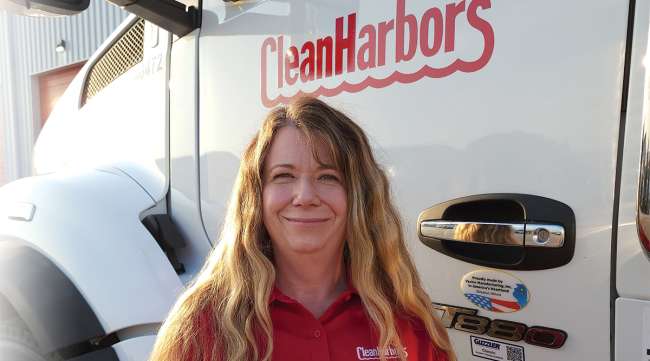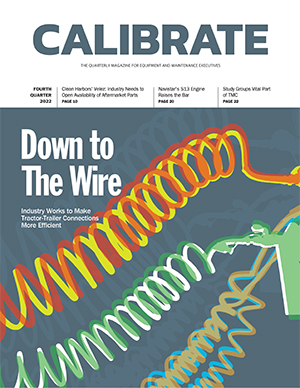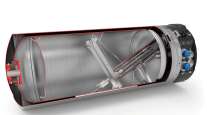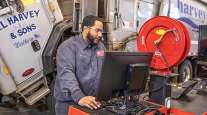5 Questions With Ginnapher Velez of Clean Harbors

[Find the latest in equipment & maintenance: Explore this quarter's issue of Calibrate]
Ginnapher (Ginn) Velez is responsible for Clean Harbors’ fleet and equipment asset and maintenance management program of 29 motor carriers and 20,000 assets. Her organization includes asset purchase, equipment life cycle management, maintenance service centers, professional technicians, inventory, purchasing, warranty and product line asset management, with a multimillion-dollar operational budget. Clean Harbors ranks No. 32 on the Transport Topics Top 100 list of the largest private carriers in North America.
What are the top maintenance-related challenges at Clean Harbors, and how are you working to overcome them in your position as the SVP of asset management and fleet operations?
The most challenging issues are parts and supply chain shortages. We are working with preferred vendors to increase internal shop fill rates and can send parts to vendors to mitigate downtime. Also, equipment uptime and reliability is an issue. We have found that increasing internalization reduces cost and downtime.
More Q4 Calibrate
►Making Tractor-Trailer Connections More Efficient
►Formulate Recap: Homer Hogg of TravelCenters of America
►Freeze: Making the Electric Transition
►TMC Corner: Recommended Practices are the Foundation of Maintenance
►Baxter: Challenging Truck Makers' Emissions Systems
Explore the Issue!
We’ve built out our shops and started growing our technicians so that we have more control. We still work a lot with our vendors, making sure that they have processes and efficiencies in place that will help get our equipment through. But we also, in some cases, have requested priority service. Those long-term relationships become extremely important.
Concerning the technician interaction and retention, we have a competency-based pay-for-performance program that allows the technicians to do additional training and receive increases and it’s self-paced.
It’s about getting into the apprenticeship programs, partnering with vocational trade schools, high schools, and then letting them know that they have a way to be successful without going to a four-year university. And hopefully beginning in 2023, we’ll have a scholarship program. So, if we recruit you out of a trade or high school, for instance, and you want to get your diesel tech certification, we’ll pay for that. We also have our partnership with the Military Veterans Group for after-service placement. There are a lot of things going on to try to attract and retain those technicians and keep them engaged.
What is your philosophy in leading your group of technicians, and how are you — in your unique position — encouraging more women to pursue a career as a technician?
I work every day to set the example from the top. My top three priorities are safety, health and the welfare of employees. We provide cost-efficient maintenance to make sure that the driver is safe on the highway and also the motoring public.
We are encouraging women to pursue careers as a technician and actually doubled our number in the past year. I really believe that’s due to a couple of things: The development of our program, encouraging women technicians — making sure the trucks have the correct lifting devices, ergonomic tooling has been a real benefit in doing that. We’ve partnered with Women in Trucking and are actively participating in their events and conferences. Building these relationships at a trade/high school, encouraging not just a certain demographic or gender to come, but everyone.
With several advances in maintenance technology, how does your team navigate these innovations to operate more efficiently as a private fleet?
The regulations aren’t different. We still have the same regulatory rules, preventive maintenance rules, FHWA rules, cargo tank rules ... all of those still apply. So that doesn’t change. I think one of the benefits we have is timing. We were appointment-based. You had to be at a customer location by a certain time, pick up the load and deliver it somewhere else. So, time was always an issue. We always push our stuff out at certain times in our line of work because we’re project-minded or waste-minded, until the project is done. We actually focus more on having equipment available in an internal rental pool, surplus pool or having project-based equipment that goes out on the job, gets made ready and then comes back.
We then turn the equipment again and get it right and make sure it’s ready to go out on another job. So, I think that the rush time helps.
For technology, we continue to invest in tooling to include diagnostic and ergonomic. We are also members of the Technology & Maintenance Council and the National Tank Truck Carriers. So, we have that open forum for discussion of recommended practices and shared experience in the technology pipeline.
Amid supply chain shortages, are you encountering any challenges related to procuring aftermarket parts? If so, how can the industry assuage those concerns?
The most difficult procurement issues are the parts you can only order by VIN number or [vendor search engine] TruckDown status. The industry needs to open availability of aftermarket parts with the same quality as original manufactured and increased availability for stock purposes, especially in support of service and tech bulletins. That is a discussion that I’m having with national account managers.
We have the same issues with parts of the chipset, NOx sensors, wiring and harnesses that everyone else is having. We have different specs according to the line of business that it’s going to go in. We’ve been partners with Peterbilt since 2012 and we do purchase also from Mack and Freightliner. We can’t just depend on one OEM like we’ve always done. We are the parent company of Safety-Kleen and HydroChem. So sometimes, we don’t know what we’re getting until the truck literally drives on the lot. And we’re very versatile that way and actually pretty good at the aftermarket.
How do you envision the fleet maintenance and repair environment for commercial trucks evolving in the next 5-10 years?
It’s going to be really tough. We already have a shortage of technicians as it is. We’re dealing with an aging workforce who may or may not be interested in electrification, and that may be where they decide they may not want to do it anymore. I think there’s also going to be a large disparity about access between the OEM and fleets. I think the “right to repair” thing will become a very big deal. With increases in vehicle cost and equipment life cycle management, we will need to keep vehicles longer. I think more of us are also moving to predictive maintenance models. It would be easier initially. It increases the cost of your vehicle maintenance, but you get to control when and where.
More focus will be on CARB/emissions restriction technology training and diagnostic challenges with business application, specifically vocational vehicles.
Electrification (battery, hydrogen fuel cell, and natural gas) brings new challenges with OEM maintenance restriction to customer internal models. Personally, I feel like the hydrogen fuel cell, natural gas model makes the most sense, but I think it’s a long-distance program.
Want more news? Listen to today's daily briefing below or go here for more info:





